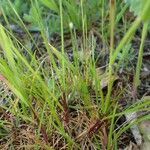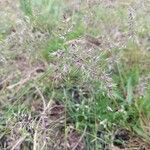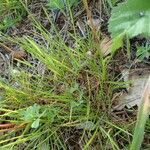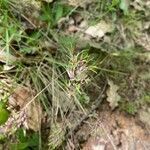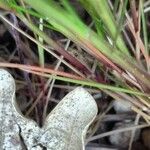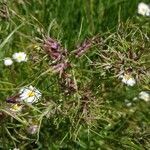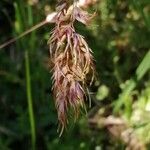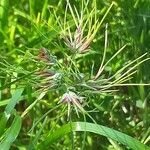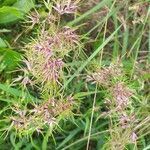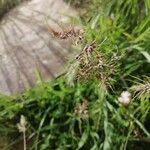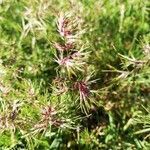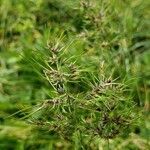Tightly packed, swollen-based perennial tufts to c. 10 cm; branching intravaginal; leaf-blades persistent. Leaf-sheath cream, membranous, glabrous, later shredding into fibres; inner basal sheaths thick, swollen and hard at base; sheaths of cauline leaves light green, some purplish. Ligule 0.5-2.5 mm, entire, tapered, apically glabrous or very sparingly ciliate, abaxially glabrous. Leaf-blade 2.5-5 cm long, rather stiff, folded, grey-green, glabrous; margins minutely scabrid, midrib also scabrid near abruptly pointed tip. Culm 5-10 cm, internodes glabrous. Panicle 2-4 cm, contracted, ± oblong, with densely packed spikelets; rachis smooth, branches few, ± erect, sparsely scabrid. Spikelets 3-3.5 mm, 2-3-flowered, light green to purplish. Glumes ± equal, 2-3 mm, ovate, acute, keel distinct, green, scabrid; lower l-nerved, upper 3-nerved; margins membranous, wide, purplish. Lemma c. 3 mm, 5-nerved, ovate, acute, membranous, glabrous, nerves densely ciliate on lower ½, midnerve scabrid above hairs. Palea c. 2.5 mm, keels minutely ciliate, interkeel glabrous. Callus with tuft of tangled hairs. Rachilla c. 0.5 mm, glabrous; prolongation much shorter. Lodicules c. 0.4 mm. Anthers 1-1.5 mm. Caryopsis not seen.
Caespitose perennial (annual in hard sites). Culms 7–45 cm high; mid-culm internodes glabrous. Young shoots intravaginal. Leaves: basal sheaths swollen and hardened, forming a bulblike structure, with margins connate in lower 1/6–1/2, glabrous, often purplish; ligule 1.5–6 (–8) mm long, acuminate to obtuse, apically glabrous, abaxially glabrous or sparsely hairy; blade flat or folded, 2–11 cm long, 1.7–2.6 mm wide (or 0.6–1.3 mm when folded), adaxially glabrous, abaxially usually glabrous or sometimes midrib scabrous towards apex or rarely puberulous. Panicles contracted, 2–6 cm long (larger in 'viviparous' specimens). Spikelets (3–) 4.2–5.5 mm long, with 3–6 bisexual florets. Glumes 3-nerved, with lateral nerves short; lower glume 2.3–3.6 mm long; upper glume 2.6–3.8 mm long. Web present or absent. Lemma 2.5–3.8 mm long, 3 or 5-nerved; keel villous in lower 1/2–3/4 and scabrous above; marginal nerves prominently ciliate in lower half; intercostal regions glabrous in lower florets and puberulous in upper florets. Anthers (1–) 1.7–2 mm long.
Culms slender to stout, erect from a decumbent (even shortly stoloneous) base, 5–10 dm, without rhizomes, smooth or often scaberulous below the infl; sheaths finely scabrous; blades soft, 2–6 mm wide, the cauline ones often 15 cm; ligule (2.5–)3–7+ mm, panicle soon long-exsert, ovoid or oblong, the ascending branches in sets of 5–8, with numerous crowded spikelets; pedicels scabrous; spikelets ovate or elliptic, 2-fld and 2.7–3.2 mm or 3-fld and 3–4 mm; glumes lanceolate, incurved, the first 1.7–2.9 mm, the second 2–3.3 mm; lemmas thin, narrowly ovate, sharply 5-veined, acute or acuminate, glabrous except the scaberulous keel and webbed base; anthers 1–2 mm; 2n=14, 28. Native of Europe, intr. in meadows, moist woods, and along roadsides from Nf. to Minn. and S.D., s. to N.C. and Ill., and in the Pacific states.
Perennial, up to 300 mm tall, culms swollen below ground. Leaves linear-filiform, mostly basal; ligule an unfringed membrane. Inflorescence a panicle, usually extending well above basal leaves. Spikelets 4-6 mm long, awnless; lower glume 1-nerved, upper 3-nerved; 2-many-flowered; producing plantlets in the spikelets, rarely making functional flowers, lower bracts soft and short, followed by a number of hard bracts, long drawn out like horns.
Perennial to 30 cm, culms swollen below ground. Leaves linear-filiform, mostly basal. Spikelets in panicles, producing plantlets directly, rarely making functional flowers.
